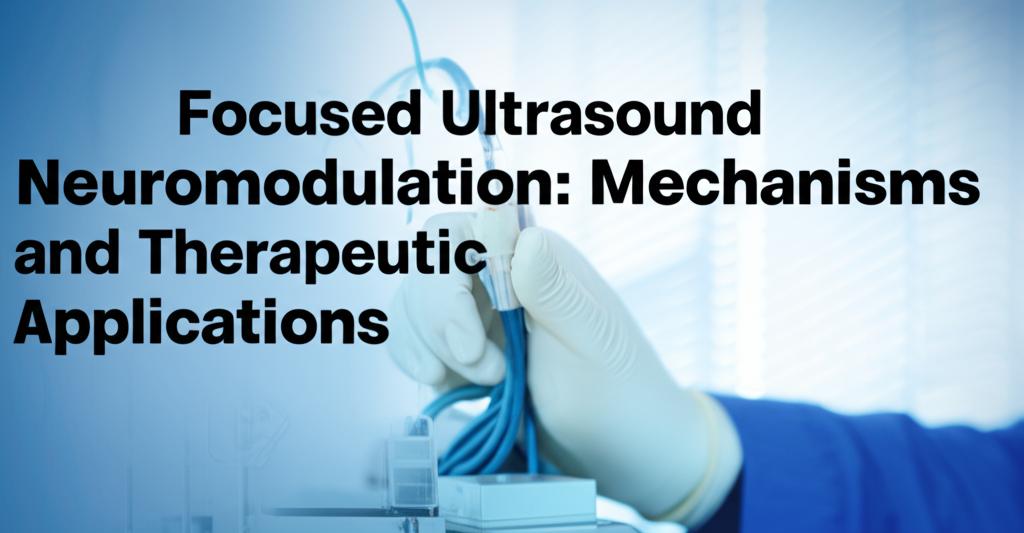Focused ultrasound neuromodulation is rapidly emerging as a groundbreaking technology for non-invasively interacting with the brain. Using precisely targeted beams of low-intensity acoustic energy, this technique can penetrate the skull to reach both superficial and deep brain structures with remarkable spatial accuracy, often on the scale of millimeters. Unlike high-intensity focused ultrasound used for tissue ablation, the low-intensity version aims to reversibly alter neural activity without causing damage.
Understanding the MechanismsThe primary way focused ultrasound is thought to modulate brain activity is through mechanical effects. The acoustic waves exert subtle physical forces on neuronal tissue:
- Membrane Interaction: Ultrasound waves cause slight mechanical deformation or apply strain gradients to neuronal cell membranes.
- Ion Channel Activation: This mechanical interaction is believed to activate mechanosensitive ion channels embedded in the neuronal membranes (such as Piezo, TRPV, K2P channels). Activation of these channels alters the flow of ions (like calcium, sodium, and potassium) across the membrane, thereby changing the neuron's electrical potential and excitability.
- Cavitation Effects: While generally minimal at low intensities, the oscillation or formation of tiny bubbles (cavitation) might also contribute by altering the local mechanical environment near neurons.
- Acoustic Radiation Force: The ultrasound wave itself imparts a small directional force on the tissue.
While LIFU typically involves minimal temperature increases (often less than 1°C), subtle thermal effects cannot be entirely ruled out as potentially contributing to neuromodulation, perhaps by influencing the conductance of thermosensitive ion channels or altering membrane properties.
Crucially, the specific parameters of the ultrasound stimulation—such as frequency, intensity, pulse duration, duty cycle (the on/off timing), and total sonication time—play a critical role in determining the outcome. Different parameter combinations can lead to either excitation (increasing neural activity) or inhibition (decreasing neural activity) in the targeted brain region. Research is actively ongoing to map these parameter-effect relationships for different brain areas and desired outcomes.
Therapeutic Applications and PotentialThe unique ability of focused ultrasound to non-invasively reach deep brain targets with high precision makes it a highly attractive potential therapeutic tool for a variety of neurological and psychiatric disorders. Key advantages include its non-invasive nature, depth penetration surpassing that of techniques like TMS or tDCS, and the reversibility of its effects.
Current and emerging therapeutic applications being explored include:
- Movement Disorders: While high-intensity focused ultrasound is already FDA-approved for ablating tissue to treat essential tremor and aspects of Parkinson's disease, low-intensity focused ultrasound is being investigated for modulating circuits related to tremor, Parkinson's symptoms (like bradykinesia), and dystonia.
- Epilepsy: Targeting seizure foci non-invasively to suppress epileptic discharges is a major area of research, with clinical trials underway showing promising early results in reducing seizure frequency.
- Chronic Pain: Modulating activity in brain regions involved in pain perception and processing, such as the thalamus, insula, and anterior cingulate cortex, is being tested in clinical trials.
- Psychiatric Disorders: Early studies are exploring the use of focused ultrasound to modulate circuits implicated in depression, anxiety disorders, obsessive-compulsive disorder (OCD), and substance use disorders, often targeting regions like the prefrontal cortex or amygdala.
- Alzheimer's Disease and Cognitive Decline: Research is investigating whether focused ultrasound, sometimes in the form of transcranial pulse stimulation (TPS), can improve cognitive function or slow decline by modulating specific brain networks or promoting neuroprotective mechanisms.
- Disorders of Consciousness (DOC): Focused ultrasound targeting structures like the thalamus aims to enhance arousal and awareness in patients with severe brain injuries.
- Amyotrophic Lateral Sclerosis (ALS): A clinical trial is currently investigating if neuromodulation via focused ultrasound can slow disease progression.
- Brain Mapping and Research: Beyond therapy, focused ultrasound is a powerful tool for researchers to temporarily and focally perturb specific brain regions or networks to better understand their function.
Focused ultrasound neuromodulation is a rapidly evolving field. While still largely experimental, the number of clinical trials is growing significantly across a range of conditions. Ongoing research focuses on optimizing stimulation parameters for specific effects, further clarifying the precise biological mechanisms, ensuring long-term safety and reproducibility, and identifying which patients are most likely to benefit. Combining focused ultrasound with neuroimaging techniques like fMRI or EEG allows for precise targeting and real-time monitoring of its effects on brain activity and connectivity.
Although challenges remain in translating this technology into widespread clinical practice, focused ultrasound neuromodulation holds immense promise as a future non-invasive, precise, and potentially personalized therapy for a wide spectrum of brain disorders.

